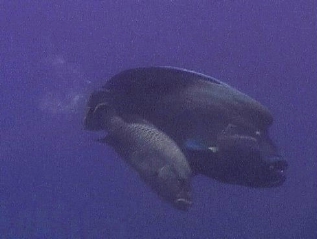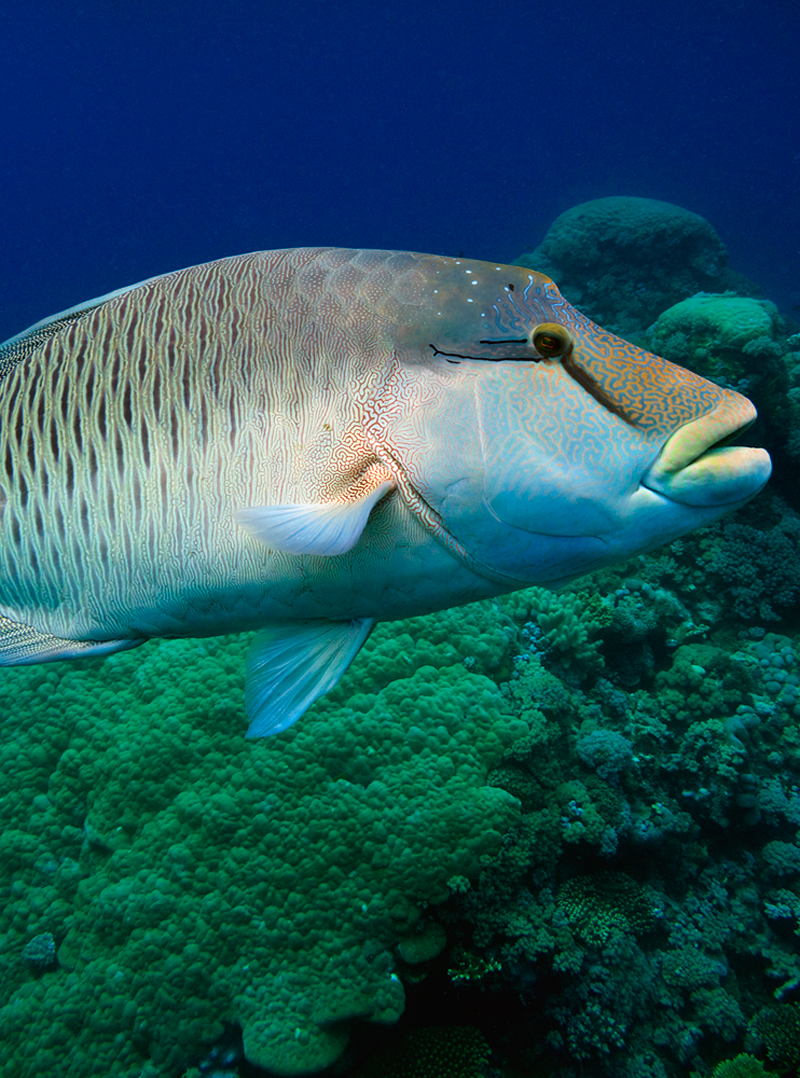How do we reproduce?
REPRODUCTION
The Napoleon Wrasse, or Humphead Wrasse, have quite interesting
reproductive patterns. These reef-located giants
gather together in large numbers to spawn, similar to groupers in
location choice (Sluka 2000). Wrasses earn the name “pelagic
spawner” because they lay their eggs in the open water.
More
specifically, the process of fertilization begins w hen the male points the anal fin,
or the fin on his stomach, down and folds the tail and dorsal fins,
on its back,
hen the male points the anal fin,
or the fin on his stomach, down and folds the tail and dorsal fins,
on its back,
against the body while hovering just above the ocean floor (Bester
2013). The females then rise up as the male swims past, releasing gametes
for fertilization near the surface of the water (Bester 2013).
Therefore, the lifecycle continues, beginning with the combination
of the gametes followed by mitosis in the gametic
lifecycle.
After the fertilization of the eggs, according to the Shedd
Aquarium, the specifically chosen current takes these eggs to float
in the epipelagic zone, or near the surface of the open ocean (Shedd Aquarium 2006). After the offspring are hatched in
the epipelagic zone, the larvae bid their time and float until they
become large enough to swim down to a coral reef environment (Shedd
Aquarium 2006).
COLORATION
Picking out a large Napoleon Wrasse is easy when compared to th e
other relatively small reef organisms! The only thing that makes the
determination a bit challenging is the multiple colors they display throughout
their life cycle. Small juvenile Napoleon Wrasses in the reefs are
easily identifiable with a black and white exterior (NOAA 2009). To
view an example of these small juvenile organisms, take a gander at
Massimo Boyer's
photograph. In contrast, the larger juveniles have developed a
pale green color and two black lines behind their eyes (NOAA 2009).
With an increase in age, the fish develop a more prominent hump on
the back of their neck, brighter colors in males like the green and
blue spots and scribbles on their heads. More specifically, females develop a
dimmer red-orange color on their upper body (NOAA 2009).
e
other relatively small reef organisms! The only thing that makes the
determination a bit challenging is the multiple colors they display throughout
their life cycle. Small juvenile Napoleon Wrasses in the reefs are
easily identifiable with a black and white exterior (NOAA 2009). To
view an example of these small juvenile organisms, take a gander at
Massimo Boyer's
photograph. In contrast, the larger juveniles have developed a
pale green color and two black lines behind their eyes (NOAA 2009).
With an increase in age, the fish develop a more prominent hump on
the back of their neck, brighter colors in males like the green and
blue spots and scribbles on their heads. More specifically, females develop a
dimmer red-orange color on their upper body (NOAA 2009).
PROTOGYNOUS HERMAPHRIDITISM
There are other differences when comparing the various stages of
this magnificent fishes’ life. Sexual maturity is reached between
five and seven years of age and, the most interesting difference is
that this species is actually a protogynous hermaphrodite (NOAA
2009)! This implies that this species can have a female-to-male sex
change (NOAA 2009). Although, the Wrasse ARE able to develop males directly
from juveniles within the life cycle as well (Sluka 2000). This sex
change typically occurs around nine years of age, according to
Cathleen Bester from the Florida Museum of Natural History, even
though Wrasses begin life with both gender organs (2013).

When they become adults, they adopt the name ‘initial phase male’,
or ‘initial phase female’. Males that were born male, never have the
chance to become a dominant male (Shedd Aquarium 2006). On the
contrary, those that have undergone a sex change from male to female
are the only fish that can become dominent males (Shedd Aquarium 2006).
Therefore, the
larger female wrasses are the only ones that have an opportunity to
become a dominant male! They have this chance because they become
“supermales” after their sex change if they are larger than the
typical individual (Shedd Aquarium 2006). They also have distinct colors
and patterns to attract more females than their lesser competition
next mating period (Shedd Aquarium 2006). Only supermales breed with
numerous females in the temporary aggregation because of their
dominance over the area and those within it due to their many
advantages (Shedd Aquarium 2006). Isn’t it interesting the adaptations
species have developed even within their own lifecycles?!?
Continue to
Interactions to learn about who the Napoleon Wrasse associates
with.
Check out our
References!
Back to
Homepage